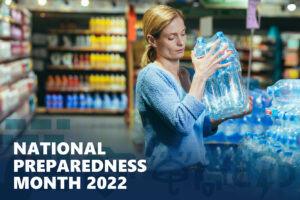You Have a Plan – Now, Do You Have a Kit? | IEM’s Top 20 Emergency Supply Kit Essentials
 Preparing for a disaster could mean the difference between chaos and control during an emergency.
Preparing for a disaster could mean the difference between chaos and control during an emergency.
The key to disaster preparedness is having a plan, part of which entails creating an emergency supply kit. An emergency supply kit should meet your family’s basic needs during a crisis, and help ease the burdens of an emergency and its aftermath.
To create a kit that will provide for you and your family during an emergency, you should identify the specific needs that kit will need to meet. Food for thought:
- How many family members will need to use the kit?
- What are their ages?
- Do they have any specific dietary or medical needs?
These are the kinds of questions to ask your loved ones when starting to create a supply checklist.
Below are Team IEM’s Top 20 essential items that should be included in a well-rounded emergency supply kit. The amounts listed are recommended minimums (3-day supply) of each item your kit should have although if you are able to, a two-week supply is encouraged.
- Water – one gallon per person per day for at least three days
- Food – a three-day supply of non-perishables (e.g., peanut butter, tuna, crackers)
- Dried fruits, snack foods, canned nuts, protein bars, non-refrigerated puddings cups are also great options
- Remember a manual can opener as well
- Pet food – three-day supply (if applicable)
- Disposable utensils, napkins/paper towels, paper plates
- Garbage bags and plastic ties for assorted uses
- Battery-powered or hand crank radio (preferably a battery powered NOAA Weather Radio that sends alerts) and extra batteries
- Battery-powered or hand crank flashlights, camping lanterns and extra batteries
- Fire extinguisher
- Wax or battery-operated candles, matches and lighters
- Emergency whistle, white flag or towel (for emergency signaling if needed)
- First aid kit (e.g., band aids, thermometer, gauze, wound disinfectant)
- Face masks (for COVID-19 and to filter debris in the air if needed)
- Personal hygiene items – toothbrush, toothpaste, soap, feminine products, hygiene wipes, waterless shampoo
- Prescription medicine or unprescribed medicine (e.g., pain relievers)
- Medical equipment and back-ups (hearing aids, walkers, inhalers, chargers, back-up batteries for medical equipment)
- Eyeglasses or contact lenses (if applicable)
- Basic tool kit (e.g., hammer, pliers, wrench, zip ties, heavy gloves) to turn off utilities or handle debris
- Cell phone chargers, back-up batteries for various items (consider investing in a solar charger)
- Printed versions of local maps with designated evacuation centers, emergency help numbers or locations, and other important locations
- Important legal documents, sealed in a waterproof folder if possible (e.g., IDs, birth certificates, banking information, deeds, insurance paperwork)
Remember that whatever bag, box, or container you choose to store the important items of your kit, such as first aid, medications, and documents, should be brightly colored and easily identifiable.
Nonessential items such as pillows, blankets, entertainment materials (e.g., puzzles, books, battery powered-television), change of clothes, and battery-powered fans are also encouraged although they are not as essential as the items listed above.
Another item to consider is personal photos. While not an emergency item they are sentimental and unreplaceable. Consider digitizing your photos or keep them in a waterproof container. Photos of children and pets should be easily available as proof of identity or ownership in case of separation.
Health Precautions
Ensure that you have plenty of disposable masks, disinfectant wipes, and hand sanitizer in your emergency kit. For specific COVID-19, Monkeypox, or seasonal flu precautions, check with the Centers for Disease Control or your local health department.
Prepped and Prepared
“By failing to prepare, you are preparing to fail” – Ben Franklin.
In unity there is strength – in the aftermath of a disaster, communities rebuild quicker if neighbors’ help neighbors. Following a disaster, check in on elderly neighbors and disabled persons nearby if it is safe to do so. Some may not have access to emergency supplies or do not have the financial means to keep a kit on hand – another reason to plan wisely. Although costly, a three-day emergency kit is a critical resource in extreme situations and should be kept in an easy-to-access area. Supplies should be inventoried, updated, or replenished two or three times a year depending on household changes.
It can be days before assistance arrives, especially following disasters like hurricanes and earthquakes. Emergencies can occur at a moment’s notice – plan ahead now to keep you and your family healthy and safe during an emergency.




